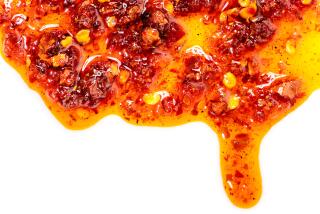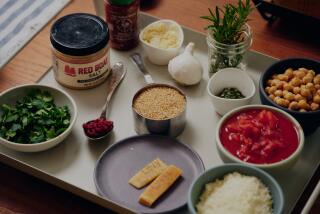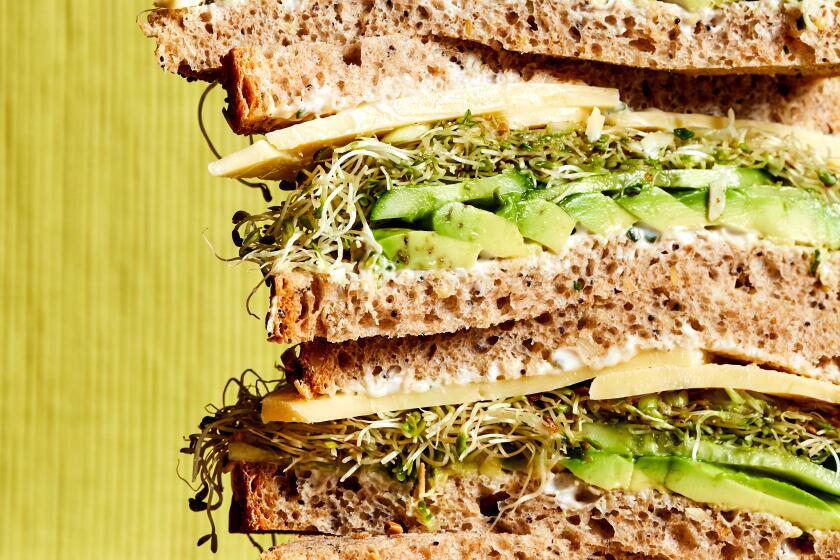Video tip: Make your own Sriracha-style hot sauce
Maybe itâs the sense of danger that reels you in at first. The crazy name, the wild picture slapped on the bottle. Before you know it, youâre in for the ride, and the best ones leave you reduced to a sweaty and speechless mess. When itâs finally over, you canât help but want more.
Iâm talking about hot sauce, a virtual thrill ride for the taste buds. And for fans, nothing beats the feeling.
So what makes hot sauce so attractive? Blame it on the capsaicin, the chemical behind a chileâs heat. When you eat hot sauce, or any chile-spiced foods, your mouth reacts to the capsaicin as if itâs in pain, signaling the brain. Your body responds by releasing endorphins, much like it does with laughter, chocolate, stress and sex.
Pleasure and pain, conveniently packaged in a bottle. All I know is I canât get enough of the stuff. I have a collection at home and drizzle at least one sauce -- more often two -- over everything. A sure sign of a junkie, lately Iâve even taken to making my own.
Itâs amazingly simple. A puree of chiles and salt, thinned perhaps with vinegar or water, maybe a secret ingredient or blend of spices thrown in for good measure. Voila.
For a quick Sriracha-type sauce, take a pound of fresh red chiles -- red Fresnos and jalapenos can generally be found year-round â and mash them with fresh garlic and salt, a touch of sugar and vinegar. A little love on the stove top -- simmering the mash helps to marry the flavors -- then blend and strain the sauce, thinning as desired with water. The sauce literally comes together in minutes (as opposed to fermented hot sauces, which can take days, or longer, to make). Though it tastes good right away, it gets even better after a day or two in the fridge. You can find a simple recipe below.
A quick note on heat: Capsaicin is found in the inner ribs, or veins, of chiles, not just the seeds. To minimize the heat (why youâd ever want to do that, I donât know), remove the ribs with the seeds. And when working with chiles, be careful. The capsaicin in the oils can burn your hands and eyes. Wear gloves when handling the hottest chiles, and work in a well-ventilated area.
Chile heat varies by type, with Anaheim and pasilla on the milder end and jalapenos and serranos packing somewhat more of a punch. Habaneros (or Scotch bonnets if you can find them) are legendary, and even naga jolokia (the ghost chile) is increasingly easier to find. For true hotheads, you can buy pure capsaicin by itself for a practically weapons-grade sauce.
Fresh green chiles are fine, though the flavor can be a little underripe and âgrassy.â Ripe red chiles are the best, though they are generally seasonal, typically available from late summer through early fall.
Dried chiles, their flavor more concentrated and complex than fresh chiles, can be found year-round. To use them in a sauce, toast them briefly over a hot skillet to add smoky notes, then soak them in hot water to soften. Once softened, they can be used just like fresh chiles.
Cooking is fun -- at least it should be! No matter how long youâve been in the kitchen, there is always something new to learn, whether itâs a simple twist on an old technique, or a handy tip to save time and energy. In this series of short videos, I demonstrate a variety of kitchen tips, including how to hold a chefâs knife for maximum control and how to use a spoon to peel fresh ginger. If you have any gadgets, kitchen tips or questions youâd like me to explore, leave a comment or shoot me an email at [email protected].
SRIRACHA-STYLE HOT SAUCE
Total time: 25 minutes | Makes about 1 1/2 cups sauce
Note: This sauce should be prepared in a well-ventilated area and is best prepared at least 1 to 2 days before using. Cane vinegar and palm sugar can be found at select well-stocked cooking stores, as well as Asian markets.
1 pound mixed fresh red chiles (such as red Fresnos or jalapenos), stemmed and chopped
2 to 4 cloves garlic
1/4 cup cane or rice vinegar
1 1/2 teaspoons sea salt, more if desired
2 tablespoons palm or light brown sugar, more if desired
1. In the bowl of a food processor, pulse together the chiles, garlic, vinegar, salt and sugar to form a coarse paste.
2. Transfer the mixture to a non-reactive saucepan and simmer, stirring occasionally, until the aroma softens or mellows a bit, about 5 minutes. Remove from heat.
3. Blend the sauce again to form a smooth paste, thinning as desired with water.
4. Strain the sauce, pressing the solids through a fine mesh strainer with a rubber spatula or wooden spoon. Taste the sauce, and tweak the flavors as desired with additional salt, sugar or vinegar. Remove the sauce to a glass jar or bottle and cool completely. Refrigerate until needed.
Each tablespoon: 13 calories; 0 protein; 3 grams carbohydrates; 0 fiber; 0 fat; 0 cholesterol; 2 grams sugar; 133 mg sodium.
Love cooking as much as I do? Follow me @noellecarter on Twitter.
More to Read
Eat your way across L.A.
Get our weekly Tasting Notes newsletter for reviews, news and more.
You may occasionally receive promotional content from the Los Angeles Times.











